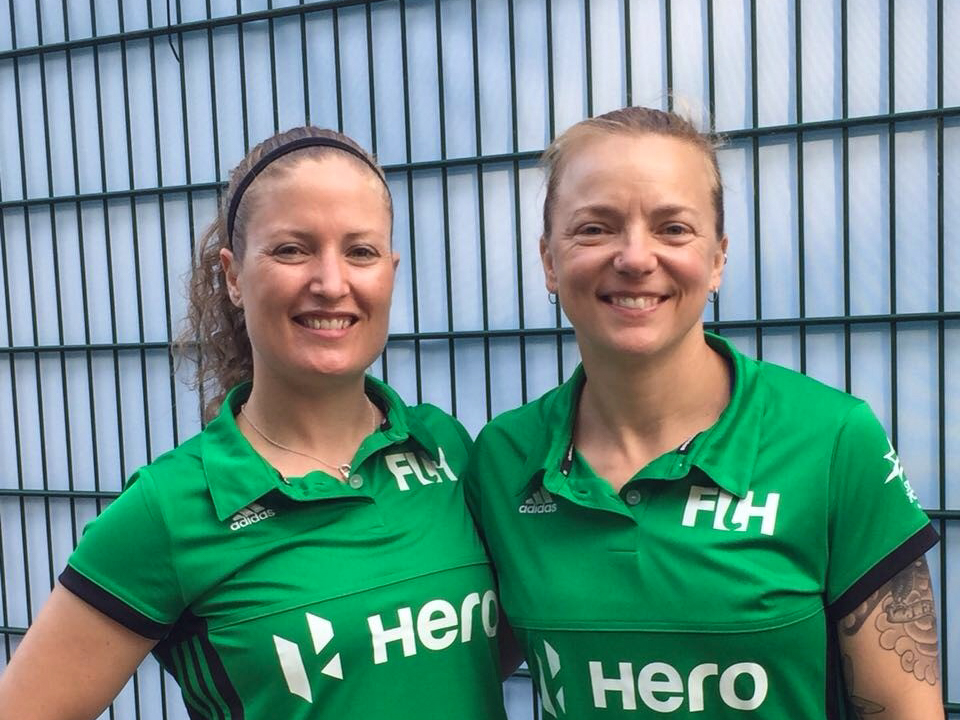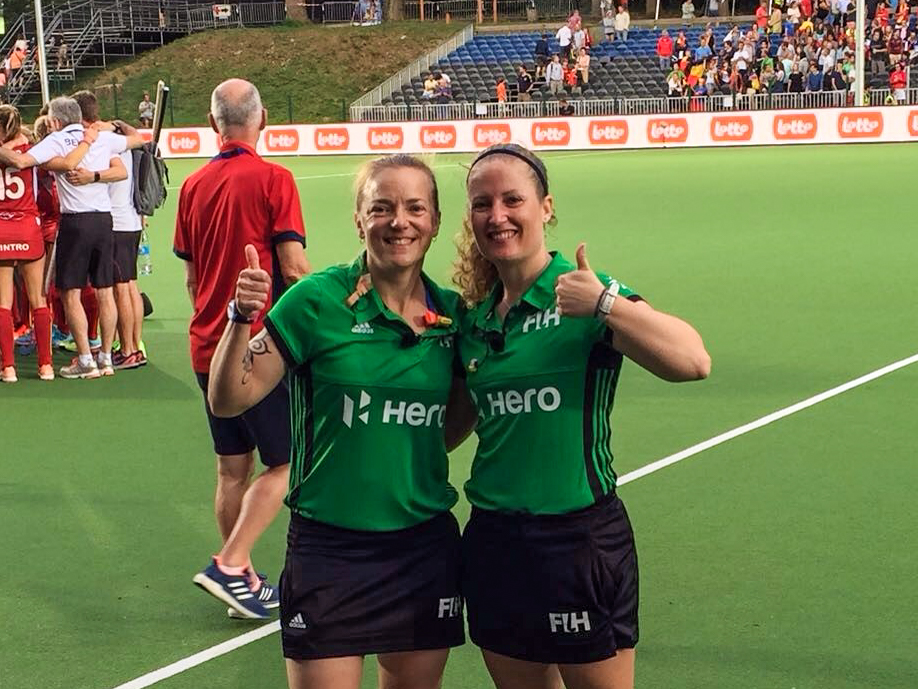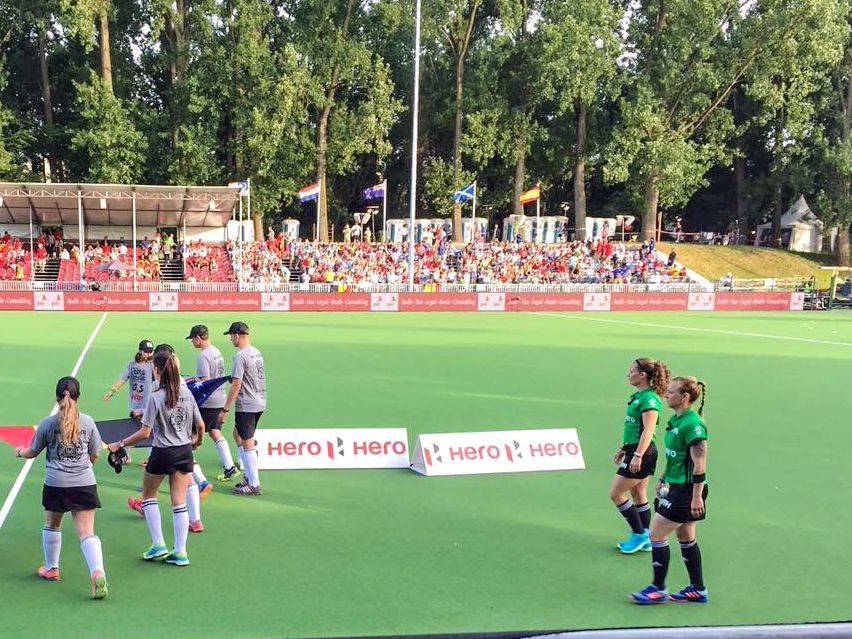
Amy Baxter (Hassick) and Maggie Giddens have taken a similar trajectory on their route to the top tier of international hockey umpiring, albeit Amy arrived at the pinnacle a shade earlier. Now, their positions as senior international umpires, makes them a valuable asset to the PAHF ambitions to raise the standard of the game across the continent.
Both began their hockey careers as players and coaches before discovering a talent and an enthusiasm for umpiring. To talk to the two women about their hopes, dreams, ambitions and achievements as umpires is to unearth two people who are as passionate about the sport as any player or coach. When Amy talks about the Great Britain match she umpired at the London 2012 Olympics, she says she can remember the moment she stepped on the pitch as if it was yesterday and it still gives her goosebumps. When Maggie recalls a match that she umpired early in her career between Australia and New Zealand, the tears that line her eyes as she talks are a clue to the immense pride she feels every time she delivers a great umpiring performance.
"I coached for three years, ' says Amy, as she explains how she found her way into umpiring. "And then I needed a break so I took a year off. But I missed hockey and wanted to stay involved. So I went to a summer umpiring clinic and I loved it. I started umpiring at middle and high school level and I cycled, walked or took the bus to the game, I would go and umpire anywhere I could get to. I was a teacher at the time, so I would go and do night games in local schools. I did two years of that and then I got into college umpiring."
Amy started her umpiring career in 2001 when, at the age of 31, she says she was relatively late onto the scene – most international umpires start umpiring top level matches in their 20s. Which explains why she threw herself so fully into pursuing her dream of reaching the pinnacle. It was a rapid rise for the umpire from Boston. "It was a little bit of luck," she says. "There were some shortages in the high school and college circuit, so they needed new umpires but I think they saw a little bit of talent too. Then, it was 'boom' right off."
Two years in as a whistle blower, Amy attended an indoor umpiring clinic. Her ability to read the game and manage the players was spotted by retired umpire, Steve Simpson, and he challenged her to reach the next level. Four years later and she had moved up into international umpiring; her first posting was a four-nations tournament in Chile between Argentina, USA, Chile and Germany.
"I was a hot mess!" says Amy laughing at the memory. "I fell over, I ran into the flags, but it was such a great experience. Then three months later I was umpiring at the Pan-Am Games. From there I went to every event the USA team went to."
To facilitate her burgeoning umpiring career, Amy had to make some tough choices. An international umpire can be away from home for many weeks of the year and, although her employers were supportive, there came a point where Amy conceded the only fair thing was to quit her job as a teacher. A conversation with her husband persuaded her that she should pursue her dreams of umpiring an Olympic Games and so Amy became first and foremost an international umpire.
"I was significantly older than many other umpires so I knew I had a limited span of time. I just went to every event I was invited to. The London Olympics was three years away so this was a chance I had to take."
A further eight years on and Amy has two Olympic Games and two World Cups under her belt, proving the wisdom of her choice.
For Maggie, the progress was equally swift. In 2006 she was coaching at a tournament at the University of Michigan and there was an umpire shortage. She stepped into the breach and was soon umpiring schools and colleges. She was mentored by Gus Soteriades and her talent was soon being recognised and rewarded. Just a year after starting out, Maggie was on her way to the Netherlands to umpire her first international and two years later, at the South American Championships in Rio de Janeiro, she earned her international badge from the International Hockey Federation (FIH).
"I have been to 15 or 16 countries since then," says Maggie, who is a fitness consultant in New York. "It has been a whirlwind but I have loved every minute of it."
The Brooklyn-based umpire laughs as she says that people often ask her if she is aiming to become a coach, but there is also a lingering annoyance that, for some people, umpiring is s second-rate career in the sport. "No," she says, "I'm 100 per cent an umpire. I used to coach and, I'm being straight up here, I didn't like it.
"What I love about umpiring is not having an emotional attachment to the team but just enjoying the game, that is what I really love. And playing my part in making a game flow well. You know the way you hold the advantage and the player scores and then you and the player get eye contact – that is the sort of moment that gives me the shivers, it is such a great moment in a match. Those are the moments I umpire for. Our job as umpires is not just about making calls, it is about understanding the game and making a good game great."
Both umpires are also committed to raising the standard of umpiring, and hockey levels generally, in both the USA and the wider PAHF region. Neither umpire has an official role in training up and coming umpires but, like Steve Simpson and Gus Soteriades before them, they are always on the look out for new umpiring talent and happily share their knowledge with local and regional umpires.
Amy is a member of the local umpiring association in New England and she passes on information she has gleaned from her FIH experience but, as she says, at the top level, things are changing constantly and it is impossible to pass everything on at once. "It is a bit-by-bit process, the game can be a little overwhelming so I just share small snippets at a time."
For the forthcoming Pan Am Cup, Maggie will be taking a leading role as one of a strong team of senior umpires. Her recent experiences in umpiring Hockey World League Round One and Two events in Mexico and Uruguay have whet her appetite to do more and more PAHF events. "Being able to give back to your sport is a pretty special thing," she says. "I always try to lead by example. I try to show younger umpires what the standard is and help them achieve that. I was in Salamanca, Mexico for HWL Round One, and I have done a couple of Round Two events. I am currently doing a Semi-Final so I am getting the full range and that is giving me a unique oversight.
"I truly believe that no matter what level it is, the players deserve the same high standard of umpiring. I am so looking forward to my first Pan Am Cup in August. I am excited, especially after this tournament [HWL Semi-Final in Brussels, Belgium].
Both Amy and Maggie share the same belief that hockey in the lower-ranked PAHF nations can only improve with more international experience. Amy equates it to her own experiences as an umpire. "You need the challenge of getting outside your comfort zone. For me, domestic hockey, which is growing exponentially by the way in the US, can only push you so far. Performing on a wider stage is the way to improve."
Maggie agrees: "The only way for PAHF standards to grow and change is for teams and umpires to get out of the immediate region. One of the most fun tournaments recently was the HWL Round Two in Uruguay, where you had Azerbaijan and France playing. The PAHF teams never play those teams normally so it was a change in style and it pushed the players out of their comfort zone."
The advent of the Hockey Pro League in 2019 is something that both umpires are watching with interest. Amy voices some concern over where the event might leave the development of some of the lower-ranked teams. "I have loved the Hockey World League because it has allowed the lower ranked teams to get out there. That would never have happened before. I am interested to see how things pan out in the future. How is hockey going to be different in the Pro League and how will it impact these smaller teams. I know there are a lot of developments happening and I really hope those developments will allow the lower-ranked nations to continue to progress."
There is an immense respect between the two umpires. Amy is visibly touched when Maggie says with her usual straight-forward honesty: "I will throw it in there, I followed Amy's umpiring from a very early moment. In 2009, when the Junior World Cup was in Boston, I was umpire Liaison and Amy had an amazing tournament. I learnt a lot from watching her, I would go as far as to say I was 'idolising' her.
"It's her energy on the pitch: we are similar in stature but her presence is such that she appears taller than she is. I remember early on that Amy taught me to get into the circle and 'touch the goalpost'. She encouraged me to be brave and get into the hub of the action."
As the interview drew to a close I asked Amy about her, now legendary, 'self-talk'. The umpire has the grace to blush: "One of my things was 'self-talk' which was okay until they started putting microphones on us. I was at the World Cup in Rosario in 2010 and there was a microphone lying on the side of the pitch. I was running backwards and I tripped over it and I fell on my pants. I let go a few choice words and of course it was live streamed. Now, I have taught myself to hum!"
The pool match between Australia and Belgium at the Hockey World League Semi-Finals in Brussels, Belgium, was the first time two USA umpires had been in charge of a top tier event together. With Irene Presenqui as the reserve umpire, it was a unique PAHF moment.


